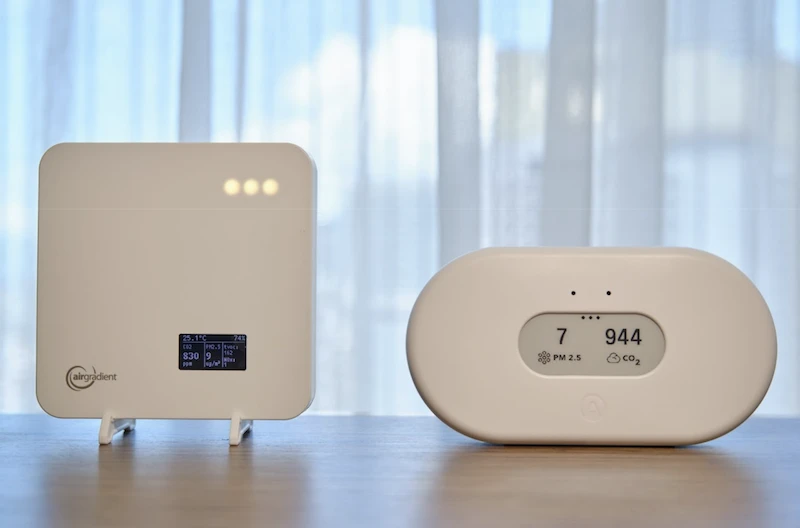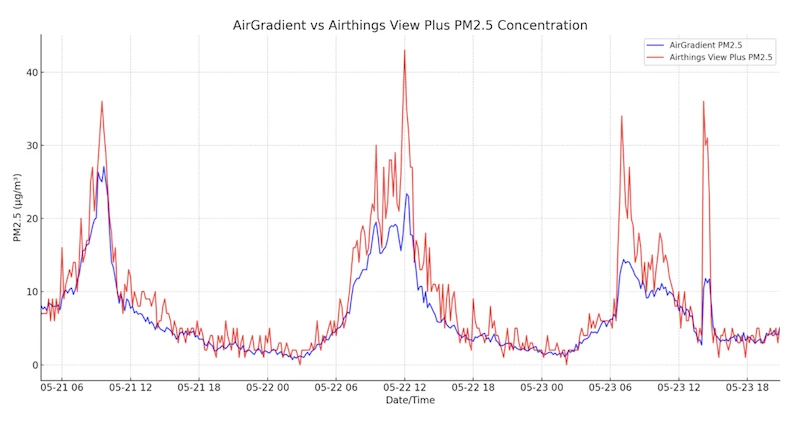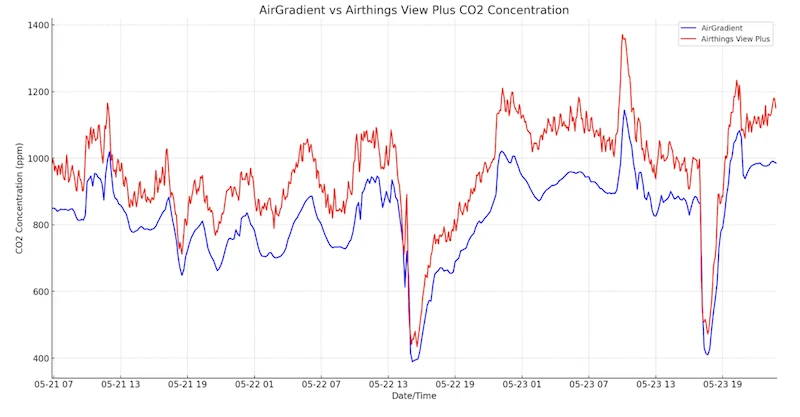Open and Accurate Air Quality Monitors
We design professional, accurate and long-lasting air quality monitors that are open-source and open-hardware so that you have full control on how you want to use the monitor.
Learn Moreby Achim Haug on May 25, 2024
Over the past decade, awareness of indoor air pollution has skyrocketed to levels never before seen. Alongside this, air quality monitoring equipment has become miniaturised and more accessible than ever before. However, there’s always been a significant barrier to entry as to how complex these monitors are to use and gather actionable insights from.
Not many brands have made strides to make indoor air quality monitors as user-friendly and straightforward to use as Airthings. Regardless of brand, we are happy to see air quality monitoring becoming more mainstream, and we recognise that this is largely due to brands such as Airthings and others making extremely user-friendly monitors.
Today, we will compare the Airthings View Plus to our own AirGradient indoor air quality monitor.

Although Airthings has other models, we have chosen only to compare the Airthings View Plus as this is the most popular Airthings monitor. This means they monitor a range of pollutants and are the best to compare to our comprehensive monitor - the AirGradient ONE (Model I-9PSL).
The AirGradient ONE, View Plus, and Wave Plus all share some common sensors but also have some differences. Below is a table showing the sensors each monitor is equipped with:
| Model | Pollutants | Meteorological Parameters |
|---|---|---|
| AirGradient ONE | PM1, PM2.5, PM10, CO2, VOCs, NOx | Temperature, relative humidity |
| Airthings View Plus | Radon, PM2.5*, CO2, VOCs | Temperature, relative humidity and air pressure |
The biggest difference between the monitors here is that Airthings opts for a radon sensor, whereas we added a NOx sensor in the AirGradient ONE. Everyone will have different preferences and requirements, but a radon sensor is especially important if you live in an area known for high radon levels (such as the U.S. Upper Midwest or Finland) or plan to use the monitor in a basement.
Conversely, you’ll likely get more use out of a NOx sensor if you suffer from respiratory issues such as asthma and live in an urban environment (especially if you live near busy roads).
The AirGradient ONE uses a Plantower PMS5003 sensor to detect particular matter. On the other hand, the Airthings View Plus use the Cubic PM2105L.
For carbon dioxide, the AirGradient ONE uses a SenseAir S8, and the View Plus uses a Cubic CM1106SL-NS.
For particulate matter, we typically see similar performance between the PMS5003 and PM2105L. The key difference between the two is in lifespan, where the PM2105L has an expected lifespan of two years (20,000 hours) compared to the PMS5003 lifespan of three years (30,000 hours). Below is a graph showing the PM2.5 concentration recorded by the AirGradient ONE and Airthings View Plus over a few days in a typical indoor setting.

Airthing’s View Plus uses the Cubic CM1106SL-NS, which has a lower stated accuracy of ±50 ppm + 3% of the reading compared to the ±30 ppm + 3% of the reading of the Senseair S8 found in the AirGradient ONE. Below is a graph showing the CO2 concentration recorded indoors by the View Plus and AirGradient ONE over 48 hours.

While this graph shows the monitors are well agreed upon in measured CO2 concentration, it highlights one issue with the Airthings View Plus: There is no way to manually recalibrate the monitor. If both monitors were calibrated the same, they would likely provide more similar readings. However, with no manual recalibration on the View Plus, we had to let it automatically calibrate over a week, and these were the results.
Additionally, there is no setting in the Airthings dashboard that would allow to manually adjust the automatic baseline calibration period which is important if you use the monitors in environments that are not well and frequently ventilated, like e.g. in basements.
Regarding accuracy, we have one final note regarding the VOC concentrations recorded by the Airthings monitors. These low-cost VOC sensors don’t record absolute values, only relative ones. This makes them useful for identifying VOC trends (increasing, steady, or decreasing levels). However, on the Airthings dashboard, these readings are misleadingly measured as ppb (parts per billion) when they are, in fact, relative. This is mentioned in the documentation for the Bosch sensor that Airthings uses.
Design-wise the two monitors are not too different. They share a similar size, both have a display and RGB color indicator and both can either be desk or wall mounted. The Airthings has the added advantage to be battery powered in case you need to carry it around whereas the AirGradient has more options for wall mount and a better cable management.
The biggest difference in design is the AirGradient ONE’s open-source hardware nature. We allow users to quickly and easily open their devices to change or replace components. This modular design makes our monitors more affordable in the long run, as there is rarely a need to replace the whole device. The AirGradient monitor has been designed from the ground-up to last and spare parts are available in our online shop.
Another key difference between these three monitors is how they connect. While you can use the Airthings View Plus and AirGradient ONE as standalone devices, their associated dashboards provide you with much more detailed information.
The AirGradient ONE uses WiFi to send data to an online dashboard, which can be accessed through any browser. On the other hand, View Plus uses Bluetooth to send data to the Airthings smartphone app. Conveniently, View Plus can also connect to WiFi and provide data to an online dashboard that can be accessed from anywhere.
The Airthings app and web dashboard lack advanced features, such as user-adjustable pollutant thresholds, manual calibration, and editing, which pollutants show when you wave your hand in front of the View Plus.
The AirGradient dashboard is a progressive web application (PWA) and can be pinned to the home screen and behave like a standard Android or iOS app. It also contains information about different pollutants integrated into the dashboard so that people better understand if the levels they see are healthy or not.
Before concluding this article, we want to examine data ownership. In the case of Airthings, restrictive terms and conditions apply. From its terms and conditions, Airthings can use, reproduce, create derivatives of, share, license, and distribute this data as part of their business operations. This means Airthings has extensive rights over the data collected by their products and services and any modifications or developments related to their products and services.
Here are some excerpts from Airthings T&Cs that we find very problematic:
In 15.4. of Airthings T&C it writes: “We own and shall retain ownership of all rights to all data and information collected via the Services provided to you…”
Furthermore, in 15.2 Airthings claims all rights for modifications that you might carry out on the Airthings monitor: “You hereby assign to Airthings all right, title, and interest (including Intellectual Property Rights) that you may have in any custom developments, modifications, or derivative works of the Services and Products created or developed by or for you, including but not limited to design, artwork, technology, software, data, functionality, and documentation.”
In contrast, at AirGradient, we believe users should have full rights to their data and device. Our full terms and conditions are here but the key points are:
The pricing may be the biggest difference between the two Airthings monitors and the AirGradient ONE.
When writing, the Airthings View Plus retails for $299, and the AirGradient ONE sells for $195 but can be purchased as a DIY kit for only $138.
Both Airthings and AirGradient can be used for free, but a paid subscription is required for advanced functionality for the Airthings. Currently AirGradient does not charge for advanced features but might do so in future.
| Criteria | AirGradient ONE | Airthings View Plus |
|---|---|---|
| PM | PMS5003 | Cubic PM2105L |
| CO2 | SenseAir S8 | Cubic CM1106SL-NS |
| VOC | Sensirion SGP41 | BME680 |
| NOx | Sensirion SGP41 | No |
| Radon | No | Airthings Sensor |
| Temperature/Relative Humidity | Sensirion SHT40 | BME680 (incl. barometric pressure) |
| Connectivity | WiFi | Bluetooth & WiFi |
| RGB LED | Yes | Yes |
| Screen | Yes | Yes |
| Data Ownership | Unrestricted | Restricted |
| Open Source Hardware | Yes | No |
| Open Source Firmware | Yes | No |
| Price for Monitor | $195 (kit available for $138) | $299 |
Both Airthings and AirGradient monitor provide good insights into indoor air quality.
The Airthings monitors are designed to be straightforward and excel in this but then lack advanced features, such as recalibrating the sensors which are important if you want to get a very high level of accuracy. Airthings has the advantage to be more portable due to its battery option.
The AirGradient ONE uses slightly higher-quality components, is open source hardware, has an open data license, and is much more affordable.
In case somebody from Airthings reads this, here is our wishlist:
Being a monitor manufacturer obviously makes us biased when comparing the AirGradient to other monitors. However, being an open-source hardware company, we are, by definition, a lot more transparent than traditional companies and believe we can make a relatively fair and objective comparison.
Curious about upcoming webinars, company updates, and the latest air quality trends? Sign up for our weekly newsletter and get the inside scoop delivered straight to your inbox.
Join our Newsletter
We design professional, accurate and long-lasting air quality monitors that are open-source and open-hardware so that you have full control on how you want to use the monitor.
Learn More